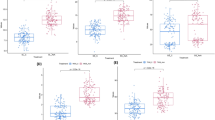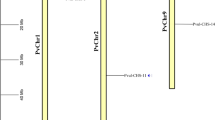Abstract
We have recently isolated the AlSAP (stress-associated protein) gene from the halophyte grass Aeluropus littoralis and demonstrated that AlSAP expression improves tolerance to continuous salt and drought stresses in transgenic tobacco. To extend these findings to an important crop, we generated marker-free transgenic durum wheat plants of the commercial cv. Karim expressing the AlSAP gene. The integration and expression of AlSAP in T3 homozygous plants were ascertained by Southern, Northern and Western blotting respectively. AlSAP wheat lines exhibited improved germination rates and biomass production under severe salinity and osmotic stress conditions. Following a long-term salt or drought stress greenhouse trial, AlSAP lines produced normally filled grains whereas wild-type (WT) plants either died at the vegetative stage under salt stress or showed markedly reduced grain filling under drought stress. Measurements of the RWC (relative water content) and endogenous Na+ and K+ levels in leaves of AlSAP plants, showed a lower water loss rate and a higher Na+ accumulation in senescent-basal leaves, respectively, compared to those of WT plants. Taken together, these results extend to cereals the high potential of the AlSAP gene for engineering effective drought and salt tolerance.






Similar content being viewed by others
References
Ayers RS, Westcot DW (1985) Water quality for agriculture. FAO Irrigation Drainage Paper 29:1–174
Ben Saad R, Zouari N, Ben Ramdhan W, Azaza J, Meynard D, Guiderdoni E, Hassairi A (2010) Improved drought and salt stress tolerance in transgenic tobacco overexpressing a novel A20/AN1 zinc-finger “AlSAP” gene isolated from the halophyte grass Aeluropus littoralis. Plant Mol Biol 72:171–190
Chen H, Nelson RS, Sherwood JL (1994) Enhanced recovery of transformants of Agrobacterium tumifaciens after freeze–thaw transformation and drug selection. Biotechniques 16:664–668
FAO (2009) Crop prospects and food situation. No. 2 April 2009
Garfinkel DJ, Nester EW (1980) Agrobacterium tumefaciens mutants affected in crown gall tumorigenesis and octopine catabolism. J Bacteriol 144:732–743
Hassairi A, Ben Saad R, Zouari N, Ben Ramdhan W, Azaza J (2008) A method for “in embryo” transformation with Agrobacterium of wheat and production of transgenic fertile plants over-expressing the AlSAP gene, isolated from the halophyte grass A. littoralis, Tunisian. Patent SN08356 17-09-2008
Hood EE, Gelvin SB, Melchers S, Hoekema A (1993) New Agrobacterium helper plasmids for gene transfer to plant. Transgenic Res 2:208–218
Kanneganti V, Gupta AK (2008) Overexpression of OsiSAP8, a member of stress associated protein (SAP) gene family of rice confers tolerance to salt, drought and cold stress in transgenic tobacco and rice. Plant Mol Biol 66:445–462
Katerji N, van Hoorn JW, Hamdy A, Mastrorilli M, Nachit MM, Oweis T (2005) Salt tolerance analysis of chickpea, faba bean and durum wheat varieties. Agric Water Manage 72:195–207
Katerji N, Mastrorilli M, van Hoornc JW, Lahmerd FZ, Hamdyd A, Oweise T (2009) Durum wheat and barley productivity in saline-drought environments. Eur J Agron 3:1–9
Katiyar-Agarwal S, Kapoor A, Grover A (2002) Binary cloning vectors for efficient genetic transformation of rice. Curr Sci 7:873–876
Murray MG, Thompson WF (1980) Rapid isolation of high molecular weight plant DNA. Nucleic Acids Res 8:4321–4325
Ohira K, Ojima K, Fujiwara A (1973) Studies on the nutrition of rice cell culture 1: a simple defined medium for rapid growth in suspension culture. Plant Cell Physiol 14:1113–1121
Rezgui M, Ben Mechlia N, Bizid E, Kalboussi R, Hayouni R (2000) Étude de la stabilité du rendement de blé dur dans différentes régions de la Tunisie. In : L’amélioration du blé dur dans la région méditerranéenne: nouveaux défis. Options méditerranéennes Sér. A: Séminaires Méditerranéennes 40:167–172
Sakiss N, Ennabli N, Slimani MS, Baccour H (1994) La pluviométrie en Tunisie a-t-elle changé depuis 2000 ans? Recherche de tendance et de cycles dans les séries pluviométriques. Institut National de la Météorologie, 283 p
Savé R, Alegre L, Pery M, Terradas J (1993) Ecophysiology of after-fire resprouts of Arbutus unedo L. Orsis 8:107–119
Sreenivasulu N, Varshney R, Kavi Kishor P, Weschke W (2004) Functional genomics for tolerance to abiotic stress in cereals. In: Gupta, Pushpendra Kumar, Varshney RK (eds) Cereal genomics. Kluwer Academic Publishers, Dordrecht, pp 483–514
Supartana P, Shimizu T, Nogawa M, Shioiri H, Nakajima T, Haramoto N, Nozue M, Kojima M (2006) Development of simple and efficient in-planta transformation method for wheat (Triticum aestivum L.) using Agrobacterium tumefaciens. J Biosci Bioeng 102:162–170
Turner NC (1981) Techniques and experimental approaches for the measurement of plant water status. Plant Soil 58:339–366
Vij S, Tyagi AK (2007) Emerging trends in the functional genomics of the abiotic stressresponse in crop plants. Plant Biotechnol J 5:361–380
Wang H, Qi M, Cutler AJ (1993) A simple method of preparing plant samples for PCR. Nucleic Acid Res 21:4153–4154
Zouari N, Ben Saad R, Legavre Th, Azaza J, Sabau X, Jaoua M, Masmoudi K, Hassairi A (2007) Identification and sequencing of ESTs from the halophyte grass Aeluropus littoralis. Gene 404:61–69
Acknowledgments
Special thanks are extended to Kh. Belhaj (CBS) and S. Abid (a teacher of English) for their critical review of the manuscript. This work was supported by the Ministry of Higher Education Scientific Research of Tunisia (contract programme 2006–2010), by the European project CEDROME (INCO-CT-2005-015468), Agropolis Fondation under the REFUGE platform, Montpellier France and The National Program for Sciences, Technology, & Innovation (NPST, King Saud University Saudi Arabia).
Author information
Authors and Affiliations
Corresponding author
Additional information
Rania Ben-Saad and Afif Hassairi contributed equally to this work and should be considered co-first authors.
The AlSAP sequence was deposited in GenBank with the accession number DQ885218 (UniProtKB: A1YAQ3).
Rights and permissions
About this article
Cite this article
Ben-Saad, R., Ben-Ramdhan, W., Zouari, N. et al. Marker-free transgenic durum wheat cv. Karim expressing the AlSAP gene exhibits a high level of tolerance to salinity and dehydration stresses. Mol Breeding 30, 521–533 (2012). https://doi.org/10.1007/s11032-011-9641-3
Received:
Accepted:
Published:
Issue Date:
DOI: https://doi.org/10.1007/s11032-011-9641-3




